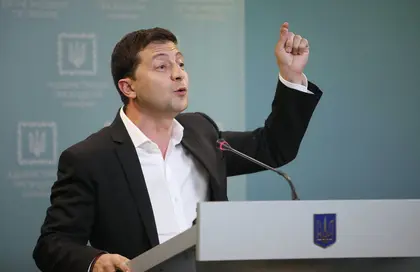Members of the Trilateral Contact Group on Ukraine – Ukraine, Russia and the Organization for Security and Cooperation in Europe on Oct. 1 agreed to a peace process known as the “Steinmeier Formula,” green-lighting local elections in the Russian-controlled regions of Donbas.
The agreement envisages that the occupied areas of eastern Ukraine get a special self-governing status after they hold local elections. The elections have to take place in accordance with the Ukrainian legislation and be approved by the OSCE.
- View the most up-to-date Ukraine news articles published today.
- Read the newest Ukraine news stories published today.
JOIN US ON TELEGRAM
Follow our coverage of the war on the @Kyivpost_official.
A key condition for the elections to take place is for the Russian forces and Russian-backed militants to leave the territory and for Ukraine to regain control over the eastern border with Russia, according to President Volodymyr Zelensky.
“There will be no elections ‘at the gunpoint’,” Zelensky said at a press conference in Kyiv on Oct. 1. “If someone (militants) will be there, there will be no elections.”
The elections in the occupied zone will be monitored by the OSCE and conducted by the Ukrainian Central Election Commission. Ukrainian observers, independent press and political organizations must be permitted to take part in the electoral process.
If the OSCE concludes that the election was fair, the region will receive self-governance instantly.
Zelensky didn’t specify what kind of self-governance the regions will obtain.
Ukraine’s leader also noted that the acting provisional law on the special territorial status for Russian-occupied Donbas would expire after Dec. 31, 2019, therefore the Verkhovna Rada would prepare a brand new legislation act on Donbas “in close cooperation and in public discussion with society.”
“And in this new law, no “red lines” will be crossed,” Zelensky said. “Therefore, there can be no instrument of surrender (in war).”
He did not specify what certain “red lines” he was talking about.
He also noted that it would be this upcoming law on Donbas that the just-agreed “Steinmeier Formula” would be implemented with.
According to Zelensky, green-lighting the Steinmeier Formula also finally paves the way for an upcoming meeting of the so-called Normandy Four of Ukraine, Germany, Russia, and France. The meeting’s exact date, however, is yet to be defined.
Besides, the Trilateral Contact Group in Minsk has a discussion regarding another stage of prisoner exchange between Ukraine and the Russia-backed militants in the Donbas. Earlier, following the previous swap held on Sept. 7, the Ukrainian leader asserted the two conflicting nations could have an “all for all” prisoner exchange next time.
The Ukrainian leader noted that one of the Ukrainians held captive in occupied Donetsk, journalist Stanislav Aseyev, had turned 30 the day before, having already spent over 2 years in custody.
“We’re applying maximal effort to bring him and all our citizens back,” the president said.
According to Zelensky, the Group also reached an agreement to launch the mutual withdrawal of manpower and weapons at the front-line sector of Zolote and Petrivske in the Luhansk Oblast. The pullout is expected to follow up the previous withdrawal of opposing forces at the Stanytsia Luhanska entry point close to occupied Luhansk, which was confirmed by the Organization for Security and Cooperation in Europe (OSCE) on June 30.
Zelensky also reacted to recent protects of local civilians in Zolote and Stanytsia Luhanska worried for their security in the wake of Ukrainian troop leaving their fortified positions defending the areas.
“I give my personal guarantees you’ll be protected,” Zelensky addressed the worried civilians. “And that the military pullout won’t have any effect on your security.”
He added that there had already been an example of successful mutual pullout at Stanytsia Luhanska, where a key pedestrian bridge for civilians for crossing the front line is meant to be completed by late November.
The governments of Ukraine and Russia have been widely discussing the so-called “Steinmeier Formula,” a peace plan proposed by the German president back in 2016, for the past several months.
Frank-Walter Steinmeier proposed the formula during his time as German foreign minister, when it became clear that the Minsk peace agreement signed in February 2015, failed.
The formula was simple: hold elections in the occupied territories under Ukrainian legislation and the supervision of OSCE, and if the organization deems these elections free and fair, then the special status of these regions will kick in.
In September, Zelensky planned to discuss the formula during the Normandy Four meeting – leaders of Germany, France, Russia and Ukraine, yet the meeting never occurred.
Political analyst Volodymyr Fesenko, in a comment to Kyiv Post on Sept. 15, said that even though all sides are willing to discuss Steinmeier’s proposals, the level of these talks may be lowered to avoid responsibility.
“The Trilateral Contact Group on Ukraine will probably sign it,” said Fesenko.
“I don’t see Ukraine as the losing side of such a process. Starting this process is more important. Creating the conditions for such elections would amount for the return of Ukraine’s state apparatus to the currently occupied territories,” said Andreas Umland, senior research fellow at the Institute for Euro-Atlantic Cooperation, in a September comment to Kyiv Post.
You can also highlight the text and press Ctrl + Enter




